Airbus is leading a new programme, the Air Mobility Initiative, to bring Urban Air Mobility (UAM) to Bavaria as a blueprint for inter-city transportation in the future. The members of the Air Mobility Initiative include Airbus, City of Ingolstadt, Deutsche Bahn, Deutsche Flugsicherung (DFS), Diehl Aerospace, Droniq, Munich Airport, Red Cross and Telekom.
The programme has three work streams to deliver a common solution.
- Vehicle stream: led by Airbus with participation from Diehl Aerospace, University of Stuttgart and others
- UTM stream: members include Droniq, Airbus, f.u.n.k.e. Avionics, SkyFive, BrigkAir, DFS, Telekom, Universities from Munich and Hamburg and others
- Vertiport stream: responsibilities for this topic are supported by Munich Airport, Deutsche Bahn, Bauhaus Luftfahrt, Airport Nürnberg, Universities of Ingolstadt and Munich.
The first vertiports would be developed for Munich Airport and the City of Ingolstadt.
Check out the press release for more details – https://www.airbus.com/en/newsroom/press-releases/2022-05-airbus-lays-the-foundations-for-future-urban-air-mobility-in
During the press conference to announce this programme, the presentations kicked off with government representatives from the German Bundestag and the City of Ingolstadt. The analogies discussed related to the introduction of the automobile. Although it will likely take five to ten years before we have real applications for UAM, consider how long it took the automobile to evolve and much it’s changed over time. In this context we are ‘likely’ moving much faster with the introduction of UAM. Ingolstadt is synonymous with Audi, which begs the question. Why Ingolstadt? This was answered specifically to address the evolution of the automobile industry and the need to have jobs for the future beyond this topic. As cars become more sustainable and more programmes are put in place for alternatives, there may be a shift in demand in the future.
The importance of inclusion of startups was also discussed. This industry is constantly evolving and needs an influx of new ideas to keep things fresh and moving at a fast pace. brigkAir hosts a digital founders centre in Ingolstadt and had a pitching contest earlier in the week looking for new startup ideas that could be incorporated in the AMI. The winner was Airial Robotics. The company describes themselves as a “new generation of commercial drones using disruptive technologies”. Great to see organisations of different sizes looking to design eVTOLs for use.
The CityAirbus NextGen began development with a solution for hover flights and then progressed to a solution for longer city-to-city flights. The NextGen unites both activites and has five key goals for its performance: eight electric propellers, four passengers, noise level no higher than 65 – 70 dbA, a range of 80 km and a top speed of 120 km/h. This might not sound too fast, but in comparison to cars who in generally move at only 12 – 13 km/h in rush hour traffic, it doesn’t sound too bad.
The goal is for the noise to be no more noticeable than background noise as one of many steps to gain passenger acceptance. Another important point is there will be a pilot in charge of the aircraft. “Safety is always the highest priority for the flying public. To gain acceptance from end customers we also need to consider sustainability and affordability. The costs and benefits for inter-city UAM to be viable need to be in relation with alternative means of transport. We can’t overlook these elements as we build our solution,” stated Markus May, Managing Director, Airbus Urban Mobility.
Traffic management will require the involvement of both UTM and ATM ‘controllers’. From the ATM (Munich Airport) side, DFS will support this requirement and from the UTM (Ingolstadt) side, it will be Droniq. UAM traffic needs to be safely integrated with existing traffic, not segregated from it, although this project will start in uncontrolled airspace. Expectations are that first flights will begin in 2023 to test hovering and migrate to maneuvering in order to learn how to control the aircraft in different conditions. This will enable the goal of certification in 2025. Jan-Eric Putze, CEO, Droniq added “that the more the flying public sees different types of drones in use for professional requirements they will realise a drone is not a toy, it’s a tool to accomplish business.”
“We can shape the mobility of the future” This is how Ralf Gaffal, CEO, Munich Airport International ended his presentation. It’s really the beginning. The beginning of UAM, although there will be a great deal of work that needs to take place to integrate eVTOLs landing at vertiport locations in a major airport.
It could seem like it’s an easy thing to integrate a new form of aircraft to an existing airport, but unfortunately, it’s not. Let’s consider some of the considerations that need to be addressed. eVTOLs will support passengers and cargo. Passengers and cargo go to different places at an airport. How do you move from an eVTOL vertiport to exit the airport, connect with another flight or move cargo (and luggage) for distribution? These flights won’t be connected to a jet bridge like other planes. These flights need to fly close to the actual terminals, they won’t be taxiing on a long runway. Munich Airport International hopes to take the blueprint they develop for the AMI programme to many locations around the world. Ralf Gaffal added, “The great thing about this initiative is that we are all running at the same speed in the same direction.”
This post has been reproduced with kind permission of Air Traffic Management magazine.
https://www.airtrafficmanagement.net/article/air-mobility-initiative-bring-uam-germany
(Image: CityAirbus NextGen Illustration, Airbus Helicopter image)




